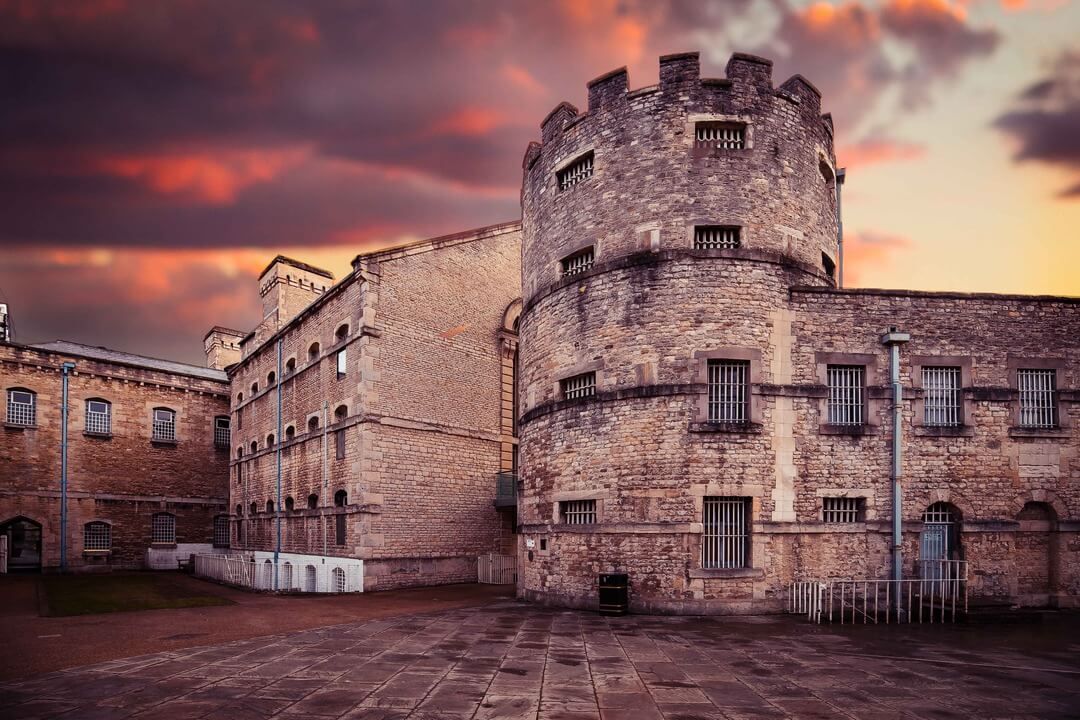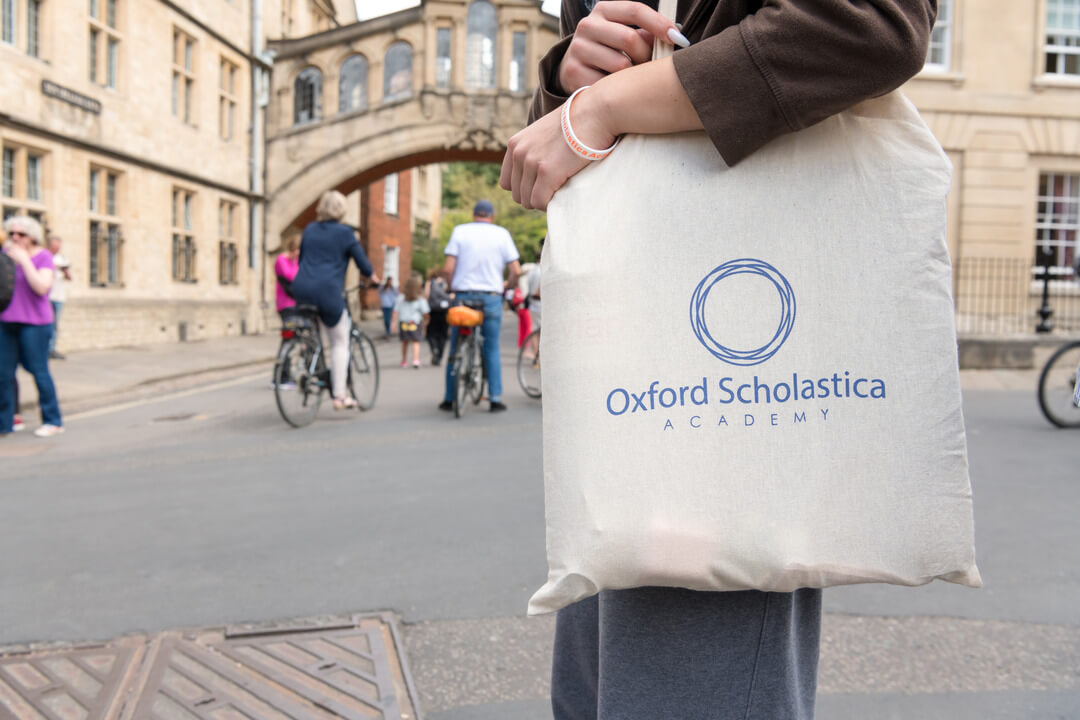Oxford Scholastica Spotlight: A Brief History of Oxford Castle

Guarding the Western entry to the city for over ten centuries, Oxford Castle and its prison are at the historic heart of Oxford. Over the years, this medieval motte-and-bailey castle has been a royal fortress, a centre for justice, and a notorious jail, and it remains an important cultural landmark for the people of Oxford.
It’s a must-see for anyone wanting to get a real taste of Oxford’s past and explore English history. The Oxford Scholastica Academy’s accommodation buildings are right next to the castle – our St George’s Gate house actually shares a wall with it! – making it the perfect place to start your exploration of all that Oxford has to offer.
Here’s a brief history of the castle to get you started:
Origins and Early History of Oxford Castle
The castle was built by the Norman King, William the Conqueror, who won the English crown at the Battle of Hastings in 1066. To consolidate his power over the conquered Anglo-Saxons, William built stone castles to imprint Norman authority on the land. At that time, Oxford was already a thriving Saxon walled town. William granted the city and surrounding land to his nobleman, Robert D’Oyly, and instructed him to build a castle.
D’Oyly built on the west side of the town, using a stream off the River Thames, now called Castle Mill Stream, to provide natural protection. The stream was diverted to create a moat, and a bailey (castle mound) was constructed and fortified with a motte (protective castle wall). In the twelfth century, the wooden motte was rebuilt entirely in stone, and the Saxon church of St George was incorporated into the walls. It was likely used as a gatehouse and watchtower, and is the largest part of the medieval structure still standing.
The castle served as a symbol of authority during the medieval period, towering above the township. It was the seat of local justice, host to royal visits, and site of important battles.
What is the Historical Significance of Oxford Castle?
Oxford Castle has played a role in many important moments in British history.
In 1142, at the height of civil war between King Stephen and his cousin Empress Matilda, the D’Oyly family sheltered Matilda there. Stephen besieged the castle, and Matilda famously escaped in the night across the frozen mill stream, wearing white as camouflage against the snow.
One of the most important documents in history, the Magna Carta, was signed by King John in 1215 to make peace with his rebellious barons. Many of the articles of this document, which protects the rights of people ruled by the British monarch, were agreed in discussions at Oxford Castle!
While Beaumont Palace (just a few streets away) was the official royal residence in Oxford, the castle was the seat of power, serving as royal court, jail, and execution site. Yearly Assizes (civil and criminal courts) were held there until the Black Plague made it too dangerous, and medieval kings met there with rebel leaders to settle uprisings several times over the years.
When the English Civil War broke out in 1642, the Royalists made Oxford Castle their headquarters – various roads around the city are still named after their barracks! After the Civil War, the castle served mostly as the county prison.
The castle is rumoured to be haunted by ghosts of dangerous criminals imprisoned and executed there. These include notorious highwayman Isaac Darkin, and Anne Greene who was tried for killing her baby. Anne was ‘executed’ at the gallows there but was later found to have survived her hanging. This was taken as proof of her innocence, and she went on to live another 15 years as a free woman.
Castle Architecture and Features
Today, the castle’s medieval moat and stonework are gone – it has undergone quite the transformation since then! When it was captured by Parliamentary forces during the Civil War, most of the medieval stonework was demolished and replaced with earth bulwarks which better absorbed the impact of projectiles. These in turn were removed after the restoration of Charles II.
In the 1770s, inspectors were so shocked at the state of the vermin-infested prison that it was rebuilt. Over the course of the next century, the castle was absorbed into the infrastructure of the city. In the late 18th century, the last of the medieval moat was filled in to make way for the Oxford Canal terminus.
In the early 19th century, new buildings were added, including the County Hall and the Oxford Militia Armoury. The prison was also extended to accommodate more inmates. These included children, like the seven-year-old girl sentenced to a week of hard labour for stealing a pram! The prison was closed in 1996.
Today, all that is left of the original medieval castle is St George’s Tower, castle mound, and the prison D-wing. The St George’s building is famous for how the architects incorporated the medieval building into the modern – there’s even an exposed medieval wall in the common room!
Visitor Experience and Attractions
Visitors can walk around the castle site free of charge any day of the year! If you want to go behind the walls, you can take part in an Oxford Castle guided tour and see the stories brought to life with plenty of interactive exhibits. You’ll get to see the 900-year-old crypt and even some of the original prison cells! You can also climb the 101 steps to the top of St George’s Tower to enjoy rare views of the city.
Preservation and Conservation Efforts
The site is now protected as a Scheduled Monument (a nationally important archaeological site or historic building). The prison buildings have been redeveloped into an award-winning restaurant and heritage complex, with open courtyards for markets and theatrical performances. Continued work to celebrate Oxford Castle’s place at the heart of city life keeps this important site safe for future generations.

So, if you’re attending an international summer school in Oxford, what better way to start exploring the city than to visit this incredible piece of history and embrace Oxford’s rich heritage? It might even complement your studies on one of the Oxford Scholastica Academy’s many summer school courses, like Architecture, Engineering, Creative Writing, or World History.
Walk back in time and get inspired for your future!

By Alice Spiers
Alice is an historian at St Anne’s College, Oxford, where she teaches undergraduate history (predominantly medieval history and historiographical theory). She is also a freelance writer and editor, and a research assistant at the Leverhulme Centre for Demographic Studies.
Would you like to explore Oxford this summer?
Recommended articles
Demystifying the UK University Application Process for Educators
The UCAS applications process for UK universities can appear daunting for students and teachers alike. With that said, educators play an important role in students’ success with their university applications. As such, it is paramount that educators understand the UK...
How to Secure Strong References for Your UCAS Applications
References are a crucial component of your UCAS application, offering a holistic view of your potential as an applicant. Your application will ask for references who can testify to your potential as a student and what you have to offer the university or college...
A Day in the Life of a History Student
It’s been over three years since I first sent my UCAS application off to Oxford University, meeting the early submission deadline by a slither and breathing a sigh of relief. Now, as a third-year History finalist on the cusp of exams, I can safely say that these...


